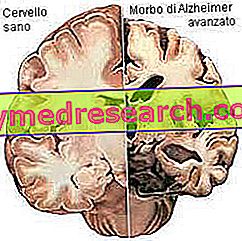What is Alzheimer's disease
Alzheimer's disease (Alzheimer's Disease: AD) is a progressive and irreversible neurodegenerative disease that affects the brain. In the elderly, it represents the most common form of dementia, understood as a progressive loss of cognitive functions;

In some individuals suffering from Alzheimer's disease, in the more advanced stages, hallucinations, eating disorders, incontinence, difficulty in walking and inappropriate behavior in public may also occur.
The progressive decline of intellectual functions leads to a consequent deterioration in social life in Alzheimer's patients, due to the loss of control of their behavioral and emotional reactions. In the final stages of the disease comes the loss of autonomy that often requires institutionalization.
In many cases, death occurs due to one or more complications related to the patient's psycho-physical deterioration.
The course of the disease is very variable even if it generally settles on 8-15 years.
Currently there is still no definitive cure for this disease. All the drugs currently available are only able to slow down its course, therefore allowing the patient to preserve cognitive functions for longer.
Symptoms
To learn more: Symptoms of Alzheimer's disease
The symptoms of Alzheimer's disease can be summarized as follows:
- anterograde amnesia: the inability of the individual with Alzheimer's disease to remember recent events, while the sick tend to maintain (relatively) a good memory of past events;
- apraxia: refers to the inability to perform common actions such as whistling, making coffee, cooking and more;
- agnosia: inability to recognize known things;
- anomia: inability to name an object while recognizing it;
- space-time disorientation: it happens when the individual with Alzheimer's is no longer able to answer questions such as "what day is today", "what month are we in", "where are we now";
- acalculia: loss of the ability to perform simple mathematical operations;
- agraphia: the subject has difficulty in writing;
- intellectual deficits: worsening of reasoning, judgment and planning skills;
- changes in mood
To date, 24.2 million people are affected by dementia and each year there are 4.6 million new cases: 70% of these are attributable to Alzheimer's. The incidence increases with age and - due to the aging of the population in more developed countries and the increase in life expectancy in emerging ones - Alzheimer's disease is becoming a growing problem worldwide.
Risk factors
Following extensive research, it has been shown that some important factors can influence the likelihood of developing dementia. For example, important risk factors for Alzheimer's disease are age and genetic makeup (which cannot be changed), but also medical history, lifestyle and environmental factors. The risk of developing dementia depends on a combination of these risk factors.
- Age: is the most significant risk factor. Although it is possible to develop early dementia, the risk increases with age. Dementia is rarely diagnosed before the age of 65. In particular, after the age of 65 the risk of developing Alzheimer's disease doubles every 5 years. Furthermore, this risk may be due to factors associated with aging such as high blood pressure, increased risk of heart disease, changes in nerve cells, DNA and cellular structure, as well as the weakening of natural repair systems to which the body meets over the years.
- Sex: It has been shown that women have a slightly greater chance of developing Alzheimer's disease than men. A possible explanation could be due to the fact that after menopause the woman stops producing estrogen. However, controlled studies have suggested that hormone replacement therapy has no beneficial effect on the development of Alzheimer's disease, and may even increase a person's risk of developing this disease.
- Genetic factors: Alzheimer's disease is generally classified into two subtypes, based on the age of the onset: we speak of early Alzheimer's (early-onset AD, EOAD) and late-onset Alzheimer's (late-onset AD, LOAD).
- Early-onset Alzheimer's disease accounts for a small percentage of all cases of Alzheimer's disease, 6%. The age at which it occurs varies between 30 and 65 years. Genetically, transmission is of an autosomal dominant type (a genetic disease caused by the dominant allelic form of a defective gene, which lies on a non-sexual chromosome, called an autosome).
- Late-onset Alzheimer's disease is the most common form, where the age of onset is over 60-65 years
Currently, the genes associated with early-onset Alzheimer's disease appear to be three:
- APP (Amyloid Precursor Protein) found on chromosome 21;
- presenilin 1 (PSEN1) found on chromosome 14
- presenilin 2 (PSEN 2) present on chromosome 1.



